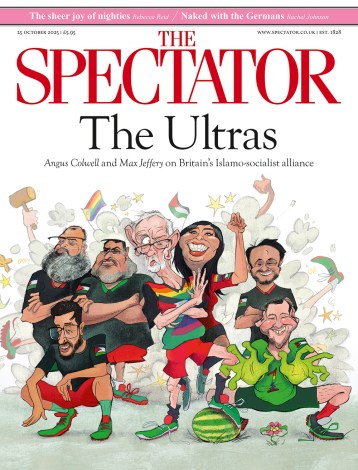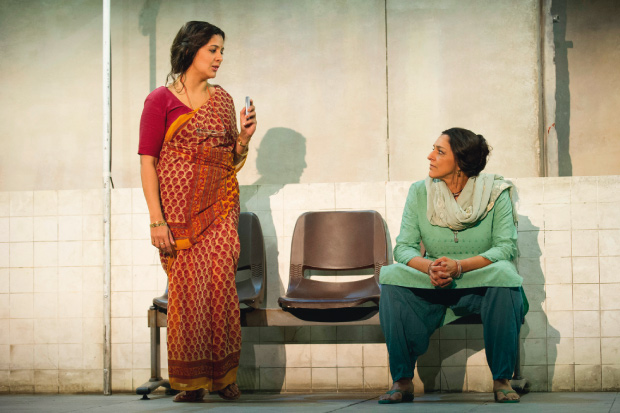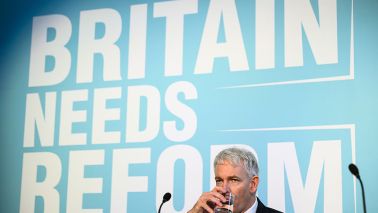Samuel Foote (1720–77) was a star of the 18th-century stage who avoided the censors by extemporising his performances. Today we’d call him a stand-up comedian specialising in improv. He served tea to play-goers and claimed that the show was a free accompaniment to the beverages. Dogged by homosexual scandals, he was hounded out of England at least once despite the patronage of George III. A riding accident left him with a compound leg fracture (bone piercing flesh), which required amputation to prevent gangrene. The limb was hacked off in 20 minutes. Foote hobbled back to fame and fortune playing Sir Luke Limp in The Lame Lover. At his burial the preserved limb was reunited with its owner.
This is the great comic biography the 18th century never gave us and the actor Ian Kelly, spotting an opportunity, has written a book on which this play is based. The show is half-brilliant. We meet Foote as a teenager taking acting lessons backstage from a leading star. (Actors earned pennies coaching hopefuls during breaks between performances.) His fellow pupil David Garrick first appears as a young bumpkin from Lichfield with Ozzy Osbourne vowels and he later becomes the darling of Drury Lane and acquires a cut-glass accent. Foote and Garrick form a partnership with Irish beauty Peg Woffington but they argue over scripts and genres. Foote loves unpretentious fun whereas Garrick is devoted to high art and virtuoso interpretations of Shakespeare. When Foote mounts a comic version of Garrick’s acclaimed Othello the two thesps, both in costume, come to blows backstage. They wallop their blackened fists into their blackened faces while their curly wigs fly in all directions. The bout is watched in mock-terror by Foote’s dresser, Frank Barber, a Jamaican.
Director Richard Eyre gives this jocular romp an atmosphere of frivolous but intelligent amusement that subtly flatters the audience. The actors clearly adore the material. Simon Russell Beale plays Foote as a twinkly desperado whose camp charm hides deep layers of jealousy and anger. Joseph Millson, a great if underrated comedian, suggests that Garrick was a bombastic peacock with an air of monumental pomposity. The writer Ian Kelly does a marvellous turn as the future George III. He begins as an amiably bumbling Prince of Wales who acquires an icy hauteur once he ascends the throne. And Dervla Kirwan is brilliantly sexy as Foote’s comic partner, Peg. But I call it ‘half-brilliant’ because the play’s best parts are front-loaded before the interval. Act Two seriously needs decluttering. There are too many themes and personalities: gay scandals, libel intrigues, medical complications, grants of royal patronage, electrical experiments, the loss of the American colonies. Everything gets thrown in. Benjamin Franklin was kicking around London at the time so he’s given a lengthy cameo. These additional motifs will work only if they serve a single storyline and a central character’s encounter with destiny. They don’t. A spot of ruthless and perhaps painful editing is required. Chop Benjamin Franklin for starters. And I’d cut George III as well. His influence can be suggested through dialogue rather than incarnated on stage. Kelly would lose his role but his script would gain enormously. At three hours, the show defies all the received wisdom of the theatre and the movie house. As Billy Wilder said, ‘In comedy, every minute over 90 counts against you.’
The Lyttelton has mounted a version of Jane Eyre in cahoots with Bristol Old Vic. It’s a weird blend of the postmodern and the traditional. Costumes and hair-dos belong to the right era but the set looks like a chimp enclosure designed by Richard Rogers. White lights glare down on a junkyard full of timber ramps, tree-house platforms and landscaped joists held together with DIY ladders. As a visual archive of Victorian Gothic this is less than a total triumph. Among the clutter looms a drum kit and a double bass which two jazzmen abuse with sadistic atonality.
Presumably this is an act of homage to Charlotte Brontë’s lost decade hanging out on the Left Bank with Sartre and Picasso. The company are effective enough but they indulge in too many rehearsal-room experiments. Mr Rochester’s dog, Pilot, is represented by an actor doing his Scooby-Doo party piece. Madeleine Worrall, in the title role, gives a solidly competent account of the 19th century’s Freddie Mercury (‘I want to break free-eee!’). Velvet-voiced Felix Hayes brings warmth and eccentricity to Mr Rochester and his oddball comic turn is the highlight of the evening. The show is utterly determined to follow every spit and cough of the original and I fear that it rather drags towards curtain-down. Revising students will find it an excellent resource. For a fun night out I’d look elsewhere.







Comments